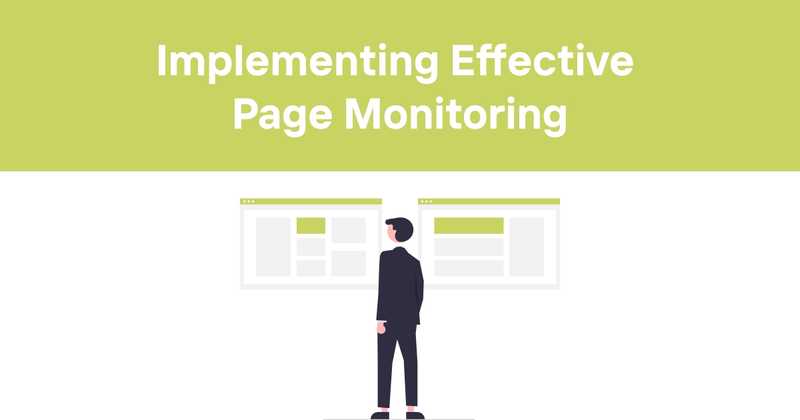Implementing Effective Page Monitoring
Website owners and developers know that a site's uptime is critical for success. But how can you stay on top of your site's performance 24/7? That's where page monitoring comes in. In this article, we'll explore everything you need to know about page monitors - what they are, how they work, and why they're essential for any serious web project.
Table of Contents
- What is a Page Monitor?
- How Page Monitors Work
- Key Features to Look For
- Setting Up Page Monitoring
- Common Issues Detected
- Responding to Alerts
- Page Monitoring Best Practices
- Advanced Monitoring Techniques
- Integrating with Other Tools
- Page Monitoring for Different Website Types
- The Future of Page Monitoring
- Choosing the Right Page Monitor
What is a Page Monitor?
A page monitor is a tool that regularly checks your website or web application to ensure it's functioning correctly. It's like having a vigilant guard watching over your site 24/7, ready to alert you at the first sign of trouble.
I've been using page monitors for years, and I can't imagine running a website without one. They've saved my bacon more times than I can count. One time, my site went down at 2 AM due to a server issue. Thanks to my page monitor, I was able to fix it before most of my users even noticed. Talk about a lifesaver!
How Page Monitors Work
Page monitors operate on a pretty simple principle: they periodically send requests to your website and analyze the response. Here's a basic breakdown of the process:
- The monitor sends an HTTP request to your site
- It waits for a response
- The response is analyzed for status codes, load time, and content
- Results are logged and compared against predefined thresholds
- If issues are detected, alerts are triggered
But don't let the simplicity fool you - modern page monitors can do some pretty impressive stuff. They can check complex user flows, monitor API endpoints, and even simulate user interactions.
Key Features to Look For
When choosing a page monitor, there are several key features you should consider:
- Frequency of checks: How often does the monitor ping your site?
- Global monitoring: Can it check your site from multiple locations worldwide?
- Alerting options: How will you be notified if there's an issue? (Email, SMS, Slack, etc.)
- Uptime reporting: Does it provide detailed uptime statistics?
- Response time monitoring: Can it track how fast your pages load?
- Custom checks: Can you set up specific tests for your site's functionality?
I once made the mistake of using a monitor with infrequent checks. My site was down for almost an hour before I was alerted. Lesson learned - check frequency matters!
Setting Up Page Monitoring
Setting up a page monitor is usually straightforward:
- Choose a monitoring service
- Create an account
- Add the URLs you want to monitor
- Configure your check frequency and alert preferences
- Set up any custom checks or advanced monitoring
Most services offer a user-friendly interface for this process. But don't rush through it - take the time to configure things properly. Trust me, future you will thank present you for the effort.
Common Issues Detected
Page monitors can catch a wide range of issues. Some of the most common include:
- Server downtime
- Slow page load times
- Broken links
- SSL certificate problems
- Database errors
- Content changes
I once had a page monitor catch a bizarre issue where my site's content was being replaced with cat pictures. Turns out, a well-meaning but misguided intern had accidentally pushed some test code to production. Without the monitor, who knows how long it would have taken us to notice!
Responding to Alerts
When your page monitor sends an alert, it's important to have a plan in place. Here's a basic process you can follow:
- Verify the issue: Check the site yourself to confirm the problem
- Assess the impact: Is it affecting all users? Just some pages?
- Identify the cause: Use your server logs and monitoring tools to pinpoint the issue
- Fix the problem: Apply the necessary fixes
- Test thoroughly: Make sure the fix worked and didn't cause any new issues
- Review and learn: What can you do to prevent similar issues in the future?
Having a clear process like this can help you stay calm and focused when issues arise. And trust me, issues will arise. It's not a matter of if, but when.
Page Monitoring Best Practices
To get the most out of your page monitor, follow these best practices:
-
Monitor critical paths: Don't just check your homepage. Monitor your most important user flows.
-
Set appropriate check frequencies: Balance between catching issues quickly and not overwhelming your server.
-
Use multiple monitoring locations: This helps catch issues that might only affect users in certain regions.
-
Set up escalation procedures: Know who to contact if the primary responder isn't available.
-
Regularly review and update your monitoring: As your site changes, so should your monitoring setup.
-
Monitor third-party services: If your site relies on external APIs or services, monitor those too.
-
Use synthetic monitoring: This involves simulating user interactions to catch more complex issues.
I learned about the importance of monitoring critical paths the hard way. I once had a major bug in my checkout process that went undetected for days because I was only monitoring my homepage. Never again!
Advanced Monitoring Techniques
For those looking to take their page monitoring to the next level, here are some advanced techniques to consider:
Content Checks
Don't just check if the page loads - check if it contains the right content. You can set up your monitor to look for specific text or elements on the page.
API Monitoring
If your site relies on APIs, set up dedicated checks for these endpoints. Monitor their response times, status codes, and payload contents.
Transaction Monitoring
This involves simulating complex user flows, like logging in and making a purchase. It's more complex to set up but can catch issues that simpler checks might miss.
Real User Monitoring (RUM)
This technique involves collecting performance data from actual users of your site. It provides a more accurate picture of how your site performs in the real world.
Error Log Monitoring
Set up your monitor to check your server's error logs. This can help you catch issues before they impact users.
I'm a big fan of content checks. They've helped me catch issues where the site was up, but critical content was missing or incorrect. It's saved me from some potentially embarrassing situations!
Integrating with Other Tools
A page monitor is most effective when it's part of a larger toolset. Here are some ways to integrate it with other tools:
- Incident Management Systems: Automatically create tickets when issues are detected
- Communication Tools: Send alerts to Slack or Microsoft Teams
- Analytics Platforms: Correlate downtime with traffic and conversion data
- Performance Monitoring Tools: Get a fuller picture of your site's health
- Status Page Services: Automatically update your status page when issues are detected
Integrating your page monitor with these tools can help streamline your processes and improve your overall site reliability.
Page Monitoring for Different Website Types
Different types of websites have different monitoring needs. Here's a quick overview:
E-commerce Sites
- Monitor the entire purchase flow
- Check inventory systems and payment gateways
- Monitor for price errors or out-of-stock products
Content Sites
- Check for content availability and correctness
- Monitor comment systems and user-generated content
- Check RSS feeds and content delivery networks
SaaS Applications
- Monitor login processes and user dashboards
- Check critical application functions
- Monitor API endpoints and third-party integrations
High-Traffic Sites
- Use distributed monitoring from multiple locations
- Monitor CDN performance
- Check database query times and server resource usage
I've worked on all these types of sites, and each has its unique challenges. The key is to understand what's critical for your specific site and focus your monitoring efforts there.
The Future of Page Monitoring
As web technologies evolve, so do page monitoring tools. Here are some trends to watch:
- AI and Machine Learning: These technologies are being used to predict issues before they occur and provide more intelligent alerting.
- IoT Integration: As more devices connect to the internet, page monitors will need to adapt to monitor these new interfaces.
- Increased Focus on User Experience: Monitors are moving beyond simple uptime checks to assess the overall quality of the user experience.
- Privacy and Security Monitoring: With increasing concerns about data privacy, monitors are adding features to check for compliance with regulations like GDPR.
- Edge Computing: As computing moves closer to the user, monitoring tools will need to adapt to this distributed architecture.
It's an exciting time in the world of page monitoring. I can't wait to see what new features and capabilities emerge in the coming years.
Choosing the Right Page Monitor
With so many options out there, choosing the right page monitor can feel overwhelming. Here are some factors to consider:
- Your technical expertise: Some tools are more user-friendly, while others offer more advanced features for tech-savvy users.
- Budget: Prices can range from free to hundreds of dollars per month. Determine what you're willing to spend.
- Site complexity: A simple blog might only need basic monitoring, while a complex web application will require more advanced features.
- Scalability: Choose a tool that can grow with your site.
- Integration capabilities: Consider how well the monitor works with your existing tools and workflows.
- Support and documentation: Good support can be a lifesaver when you're trying to diagnose tricky issues.
Personally, I've found that it's worth investing in a robust monitoring solution. The peace of mind and potential savings from catching issues early are well worth the cost.
When it comes to reliable and comprehensive page monitoring, Odown is an excellent choice. It offers a range of features including website uptime monitoring, API monitoring, and SSL certificate monitoring. Plus, its public status pages keep your users informed about your site's performance.
With Odown, you get frequent checks, global monitoring locations, and flexible alerting options. It's user-friendly enough for beginners but powerful enough for advanced users. Whether you're running a small blog or a complex web application, Odown has you covered.
Remember, the best page monitor is the one that meets your specific needs and helps you sleep better at night. Choose wisely, and your website (and your stress levels) will thank you.



